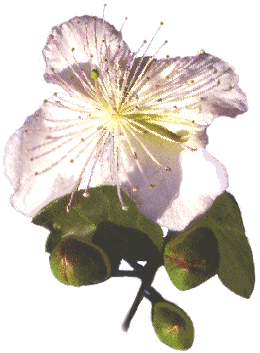...Best of Sicily presents... Best of Sicily Magazine. ... Dedicated to Sicilian art, culture, history, people, places and all things Sicilian. |
by Roberta Gangi | ||
Magazine Index Best of Sicily Arts & Culture Fashion Food & Wine History & Society About Us Travel Faqs Contact Map of Sicily |
It is believed that capers originated in western or central Asia, though it has also been suggested that capparis spinosa is native to the Mediterranean Basin, which encompasses the Black Sea and other regions touching western Asia. The Roman author Pliny the Elder, who wrote about Sicilian cuisine, mentioned capers, and so did ancient Greeks. Capers similar to those of Pantelleria grow in many Mediterranean countries. The caper itself is the bud of a flowering plant, and the stage at which the buds are harvested is very important. Some caper buds sold for the culinary market are quite large, reaching over two centimeters (almost an inch) in diameter, though most are much smaller. Capers' strong, distinctive flavor comes from mustard oil. Capers are high in rutin, but are usually consumed only as an enhancement. In Sicilian cuisine, the eggplant (aubergine) salad known as caponata is made with capers. They are often sold either salted or in vinegar or brine. To eliminate these other flavors, it is usually best to soak capers in cold water and strain before serving. Cultivation and harvesting is labor-intensive, having changed little in centuries. The "caper berries" are harvested from plants which rarely reach a meter in height. As the buds are picked before blossoming, caper flowers are a rare sight. In some regions, however, capers grow wild. Strongly identified with Italian cuisine, capers are also cultivated on a large scale in Spain. It was the Spaniards who introduced capers in the Americas. In fact, Pantelleria is one of the few Italian regions where capers are still grown, though capers are also raised in the Aeolian Islands off the Sicilian coast near Messina. Cyprus, Greece, Dalmatia, Provence and Morocco are also known for caper production. Capers are not as prevalent in Sicilian cuisine as one might expect, but creative uses abound. Potato ("Russian") salad, for example, may be enhanced with a few capers, while the buds make an appealing garnish for many dishes. Capers are one of the spices that make life more pleasant. About the Author: Roberta Gangi has written numerous articles and one book dealing with Italian cultural and culinary history, and several food and wine articles for Best of Sicily Magazine. | |
Top of Page |
 Capers are grown in southern Italy, but particularly on the island of
Pantelleria off the Sicilian coast. It's a perpetually windy island, where
the olive trees are pruned to a squat form to survive heavy gusts, and the
perfect place for caper plants, which grow close to the ground. The plant,
capparis spinosa, belongs to the family capparidaceae. There are various
varieties of caper, particularly in central Asia and India.
Capers are grown in southern Italy, but particularly on the island of
Pantelleria off the Sicilian coast. It's a perpetually windy island, where
the olive trees are pruned to a squat form to survive heavy gusts, and the
perfect place for caper plants, which grow close to the ground. The plant,
capparis spinosa, belongs to the family capparidaceae. There are various
varieties of caper, particularly in central Asia and India.